The physics of inspiration: teaching in Austria Inspire article
Gyro-cars, gymnastic cats and a slow-motion slap in the face. Lucy Patterson spoke to Rudolf Ziegelbecker, an Austrian physics teacher, about how to catch the imagination of even the most anti-physics students.
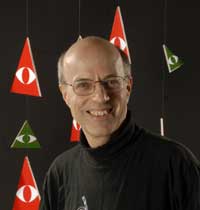
Image courtesy of
Ortweinschule Fotografie
Unenthusiastic students can be a challenge for even the best teachers. Rudolf Ziegelbecker teaches physics at an Austrian school specialising in civil engineering and in art and designw1. With such a strong focus on vocational education in the curriculum, teaching more traditional academic subjects, such as physics, can be a challenge. “Many of the arts students who choose to come to our school are not very good at mathematics and science. Nonetheless, the curriculum requires them to study physics for the first three of their five years here. Unsurprisingly, some students are quite unwilling to learn.”
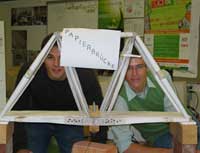
can carry up to 1.6 tonnes
Image courtesy of Rudolf
Ziegelbecker
Rudolf enjoys sharing his own enthusiasm for physics and encouraging the students to develop their own ideas. This has led to some impressive successes over the years, often in collaboration with his colleagues from other disciplines: building a paper bridge which can carry up to 1.6 tonnes, boats light enough to float on gaseous CO2, and innovative paper boats which can carry several kilograms despite weighing only 10 grams; designing a sustainable solar and hydro-electric power plant for the local river, and a (fish-shaped) aerodynamic vehicle which they tested in a home-made wind tunnel…
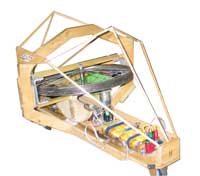
open day in November 2009
Image courtesy of Rudolf
Ziegelbecker
One award-winning project was the gyro-car: together with eight volunteer students in an afternoon physics club, Rudolf designed and built a remote-controlled 1 m long gyromobile capable of balancing automatically on its two wheels. It was exhibited at science shows, presented at Physics on Stage 2000w2, and appeared on TV during the Austrian Science Week 2003, crossing the local river Mur while balancing along the handrail of the main bridge in Graz. The project was a big hit for the school and the students involved: “It helped me realise that, sometimes, the impossible can be possible,” as one of the students put it.
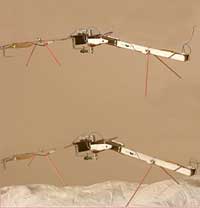
Image courtesy of the HTBLVA
Graz Ortweinschule
In 2002-2003, Rudolf and his students took on another project: ‘The turning cat’ was to be a robot that could simulate a falling cat’s righting reflex – how the cat twists to face downwards for landing, without changing its net angular momentum (zero). After a series of prototypes, the team designed and built what Rudolf believes to be the “only radio-controlled cat model in the world”. Operated by remote control, it can be turned during freefall for a perfectly upright (albeit cushioned) landing. Their project won several awards and prizes, and is still proudly shown at every school open day.
Rudolf also tells the story of a shy girl who had not dared to confess to her previous teacher that she was actually interested in physics. When a student dropped out of the school’s team for the Austrian Young Physicists’ Tournamentw3, Rudolf suggested she join. He successfully coached her, and she even ended up in the team representing Austria in the international tournament in Australiaw4.
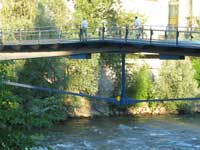
added to the pedestrian
bridge in Graz after two of
Rudolf’s students discovered
that its resonance was
dangerous
Image courtesy of Rudolf
Ziegelbecker
Inspired by a ‘string telephone’ experiment on resonance that she had performed for the contest, she then came up with a very practically minded diploma project for her Matura: “Crossing a pedestrian bridge in Graz with a classmate, the two friends noticed how it seemed to resonate rather a lot, so they decided to do their project on the resonance of bridges.They took friends and family to the original bridge to measure its resonance, and ‘tested’ it so thoroughly that at one point the supervising teacher decided to call off the experiment for fear of the bridge collapsing! They filed their results with the city authorities of Graz. As a consequence, the bridge was closed, investigated by stress analysts, and re-opened only after the resonance had been damped by spring-coupled masses which you can see under the bridge today,” Rudolf says.
Most recently, Rudolf and his students participated in the 2010 ‘Jugend innovativ’ competitionw5, a national innovation award for secondary-school students aged 15 and above. “I started the project in two classes, but after a few weeks, the other classes became interested as well, and eventually joined and contributed to the final report.
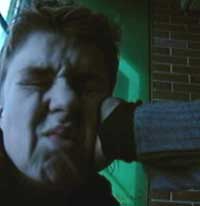
repercussions of a slap in
the face?
Image courtesy of Robert
Purkarthofer
Although we didn’t win any prizes, it was an invaluable experience for the students. We used a cheap high-speed camera to film a range of effects – from the vibrations of a stretched rubber band or the firing of a blowpipe shot, to what happens to the water in a water-bomb when it bursts, or even the (scientific) repercussions of the slap of a girl’s hand on a boy’s face (without my permission! But at least it got them interested in the science) – and then analysed the slow-motion replay in order to understand the physical principles involved.
“This project managed to engage even some of my most anti-physics students in a second-year graphics design class, who, intending to pursue a career in arts, were convinced they’d never need physics again in their lives. I appealed to their honour, showing them what the first-year arts students had achieved. This got them interested.
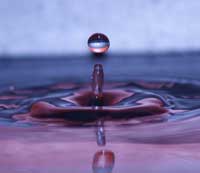
drop hit the water surface?
Jakob Jöbstl investigated at
home, inspired by the school
project
Image courtesy of Jakob Jöbstl
They performed their own experiments on one of the ideas – observing what happens to a drop of water falling onto a water surface. Soon, the entire class was involved in a scientific discussion about the fact that, when the drop hits the surface, a chain of drops leaps back up, raising questions like ‘How much of the initial energy and volume is conserved in these secondary drops? Are they composed of literally the same liquid as the first drop? Is the effect caused by surface tension, wave reflection or hydrostatic pressure?’
“For the project’s success, it was essential that almost all of the ideas emerged from the students. The feedback was really positive: those students who had initially been most sceptical and disinterested were those who by the end of the project were not only much more respectful – of me and of the lessons – but also seemed to have developed a new-found interest in physics! And it seems to be lasting.”
A special type of school
After middle school, at the age of 14, students in Austria have at least one more year of compulsory school education. If they wish to go to university, they can attend a secondary school for four more years to obtain the Matura (final secondary-school examination, required to enter university). Alternatively, they can spend three to four years at a vocational school, or five years at a combined technical college, which not only offers the Matura, but also the completion of a professional education. The HTBLVA Ortweinschulew1 in Graz is such a college, catering for 14- to 19-year-olds and specialising in civil engineering and in arts and design.
Web References
- w1 – Find out more about the HTBLVA Graz Ortweinschule here: www.ortweinschule.at
- w2 – Physics on Stage – now Science on Stage – is a European initiative designed to encourage teachers from across Europe to share best practice in science teaching. See: www.scienceonstage.eu
- w3 – To learn more about the Austrian Young Physicists’ Tournament, see: www.aypt.at
- w4 – Find out more about the International Young Physicists’ Tournament here: www.iypt.org
- w5 – The ‘Jugend innovativ’ website offers more information about this Austrian competition for secondary-school students. See: www.jugendinnovativ.at





